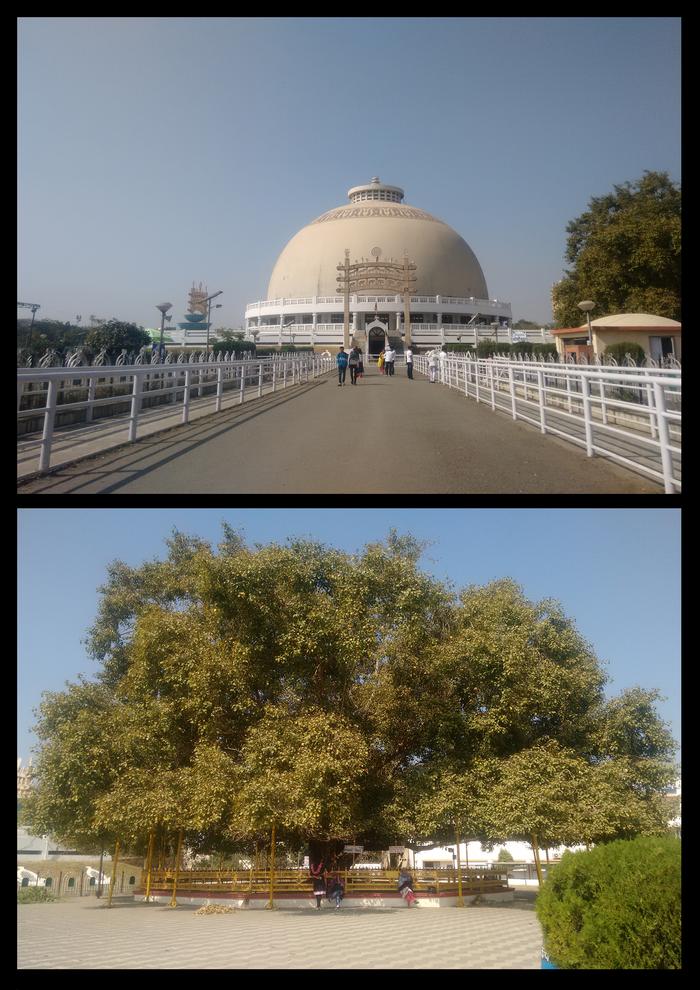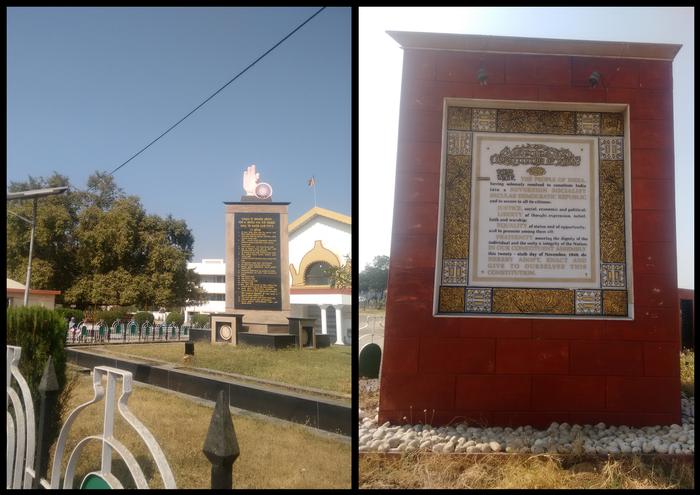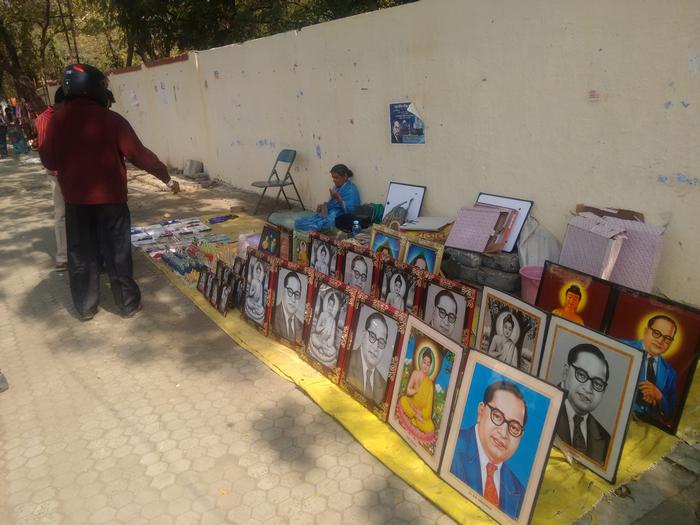[ID:2161] AN ARCHITECTURE OF COHESIONIndia “It was the year 1954. I was late from the somewhere and it was getting dark. For only a kid that I was, I used a particular path which was forbidden to the people of my community out of the fear of getting home late. Though none saw me coming using that path, my own father thrashed me up badly when I told him about it. It felt like I’ve had committed a cardinal sin. In those days, the grown-ups in my community were so afraid of the consequences that they never even questioned about the existence of such unfair customs”, reminiscences Vijay Shamraoji Deogade, one of the many security guards at Deekshabhoomi.
The social stratification in India has pre-modern origins, which was transformed by various ruling elites in the history of India. The flourishing of outside powers in the Indian commonwealth, especially the Mughal Empire and the British Raj was the payback of this paradigmatic ethnographic categorization of the people. And when the policymakers realized that the aforementioned dissensions have thwarted the amelioration of the nation enough, the basic structure of the Constitution of India was revised. Through the 42nd Amendment in 1976, the words ‘socialist’ and ‘secular’ were added between the words ‘sovereign’ and ‘democratic’ and the words ‘unity of nation’ were modified to ‘unity and integrity of the nation’. This connotes that the government of India respects all religions and it does not uplift and degrade any particular religion. Thenceforth, there is no such thing as a state religion for India.
In 1935, Dr. Bhimrao Ramji Ambedkar, the principal architect of the Constitution of India had declared that although he was born as a Hindu but he would not die as one. He believed that conversion was the solution to demolish the caste system, which has hindered the country’s progress for a very long time. After this declaration, he extensively studied the doctrines of all the major religions to choose Buddhism for himself and his followers. On October 14th 1956, Dr. B.R. Ambedkar, or as he is fondly called Babasaheb, embraced Buddhism along with his 600,000 followers to end the caste-based apartheid that previously prevailed in India. Nagpur was chosen for the ceremony because it was believed to be the homeland of ‘Nag’ people who were the early propagators of Buddhism in India. And in such manner, Nagpur become the birthplace of the Neo-Buddhist movement in India.
“…However convinced we are at an intellectual level of our commitments to a creed, we will remain reliably devoted to it only when it is continually affirmed by our buildings. In danger of being corrupted by our passions and led astray by the commerce and the chatter of our societies, we require places where the values outside of us encourage and enforce the aspirations within us.” –Alain De Botton (The Architecture of Happiness, 2006)
After the conversion ceremony, Dr. Ambedkar Smarak Samiti (Dr. Ambedkar Memorial Committee) was concocted for the management of Deekshabhoomi. The word Deeksha literally means 'act of ordaining' and bhoomi means the 'ground'. Ergo Deekshabhoomi means the ground where people got ordained as Buddhists. The committee decided to build a monument to commemorate the endeavors of Babasaheb and the Dhammachakra Parivartan (mass conversion into Buddhism).
The Memorial Committee holds a far-reaching 27.5 acres of land in the south-western corridor of the city of Nagpur. Apart from the stupa, it also subsumes a residential building for the monks known as the ‘vihara’, and the Dr. Ambedkar College (abbreviated as DACN) that functions under the aegis of the Dr. Ambedkar Memorial Committee. The college offers various courses at undergraduate as well as postgraduate levels. The premises also boasts of one of the best Cricket academies in the Vidarbha region with many leonine players having associations with it. The south-eastern lot of the premises is most useful during the major occasions.For most of the year, it remains derelict only to be underutilized by the visitors and the students as a parking space for their vehicles. While the surrounding built environment of the Deekshabhoomi is outright monotonous, the stupa doesn’t blend in and thus adds a fascinating medley to the skyline. In the process of intervening morphologically into the urban fabric, it has also evolved into an icon for the city, which the local people have familiarized with.
The largest hollow stupa amongst all the Buddhist stupa in the world, this dome is a large two-storied hemispherical edifice, with gates on four sides, resembling the world renowned stupa at Sanchi, Madhya Pradesh. The gates are articulated with Ashoka Chakra, elephants, lions and horses- bearing resemblance to the sigils of Emperor Ashoka – the Mauryan ruler who promoted Buddhism in India. The ground floor is a square hall. It has a gigantic idol of Lord Buddha in the sanctum sanctorum, donated by the quondam Thai students pursuing their education in the Nagpur University. It also has an exhibition space, showcasing various events in the life of Lord Buddha and Dr.Ambedkar, through an array of photographs and paintings. The exhibition serves as an epiphany for the younger generation of community- promulgating them of the hardships their forefathers had to go through until they could finally lead their lives with dignity. Both the floors can accommodate up to five thousand monks each.
The upper floor is a hollow dome, surrounded by a passage which is concentric to the walls of the dome. Its gates open up towards the four gates of the stupa. Four inverted hemispherical fountains are also placed on all the four sides. The upper floor remains closed for the most part of the year and is opened up for prayers by the monks only during major occasions.
Although being a significant omphalos of Buddhism in India, very few monks can be seen at Deekshabhoomi unlike in the case of Bodh Gaya and other religious Buddhist destinations in South East Asian countries like Sri Lanka, Thailand, etc. This peculiarity can also be attributed to the fact that majority of the monks reside at Nagaloka, a Buddhist training and conference center located at a distance of fourteen kilometers from Nagpur. Furthermore, the momentousness of Deekshabhoomi is more socio-cultural than religious. The religion is still penetrating its roots in the soils of the region to boot.
The Bodhi Tree is an important characteristic element of the whole complex. It was planted from three branches of the Bodhi tree at Anuradhapura in Sri Lanka by Bhadant Anand Kausalayan, as a mnemonic to Buddha’s enlightenment.
“Freedom is man’s capacity to take a hand in his own development. It is our capacity to mold ourselves”- Rollo May (Man’s Search for Himself, 1953)
Ever since the day of conversion in 1956, the population of Neo-Buddhists in Nagpur and surrounding regions has witnessed a melodramatic upsurge. According to 2001 Census report of the city of Nagpur, Neo- Buddhists comprise of 15.57 % of the city’s population, approximately amounting to 375,000 people. These people migrated with their families from their towns and villages, the atrocious locales where they were forced to live under the weight of poverty and the oppressions of upper caste Hindus. They relocated in search of jobs and to begin a new life of honor. Almost all of them came with nothing and begin settling in the vicinity of Deekshabhoomi. As of 2017, the south- western Nagpur is notably one of the best areas to live in. With its posh neighborhoods and wide, clean and attractive streets, the crime rate of this region is the lowest in the city. Moreover, some of the nation’s premier centers of research- the National Environment Engineering Research Institute, a National Institute of Technology and the University’s Agriculture College are also in the vicinity of Deekshabhoomi.
Dr. B. R. Ambedkar also established a central institution, called as the Bahishkrit Hitakarini Sabha, in order to bring about a new socio-political awareness among the depressed classes.The founding principles of the Sabha were. "Educate, Agitate and Organize". This triumvirate formed not simply the slogan of the Bahishkrit Hitakarini Sabha, but in fact embodied the ideological basis of the entire movement itself. His educational relevance lies in the fact that he identified the power of knowledge as a critical element in the construction of modernity in India.
It is due to the alacrity of Dr. Ambedkar that the Neo-Buddhist community is one of the most educated communities in India. As an outcome of their educational advancements, they were able to get into government services. As of today, Neo- Buddhists have the largest number of IAS (Indian Administrative Services) officers amongst all the other religious minorities. Furthermore, the highly qualified Buddhist youth are settled in various countries across the globe and are combating the cause of their fellow brothers either individually or collectively through various Ambedkarite International Organisations.
In 2006, four members of a family belonging to a depressed caste were brutally murdered in a small village called Khairlanji, which is at a distance of ninety kilometers from Nagpur. It was a massacre to uphold the feudal values in a modern, democratic India. The perpetrators had not massacred the family in a fit of rage. Their anger was not momentary. It did not emanate from any personal enmity. The family had not done anything to provoke or to tick them off. The only ‘crime' the family had committed was to make efforts to escape the low social status ascribed to their ex-untouchable caste. The women of the family were paraded naked and sexually abused before being hacked to death. The fact that they were trying to come out of the dehumanized existence the Dalits have been condemned to for centuries, was a provocation enough for the killers belonging to the dominant castes. Such an atrocity mustered the outrage of the entire nation. Protests against the killings took place in various parts of Maharashtra. Albeit many people in the Buddhists community got enraged, a monstrous catastrophe was averted by the community as a whole, who clutched to their resolve. The legacy of Lord Buddha and Dr. Babasaheb Ambedkar never allow the people of the aforementioned community to take up arms in their hands or to use the path of violence. Instead, following the footsteps of Lord Buddha and Dr. Ambedkar, their response to this societal conflict continued to be in a democratic framework. This depicts the power of the Constitution of India if implemented in right spirits. Peaceful protests and demonstrations were organized at the Deekshabhoomi grounds using constitutional methods. The convicts were consequently punished as they deserved for their horrendous inhumane act.
Communication leads to community- that is, to understanding, intimacy and mutual valuing. – Rollo May (Power and Innocence, 1972)
The surroundings of the Deekshabhoomi has also become a successful venue for students. As I walked around the stupa, I witnessed many groups of college students sitting around various spots. While a few girls were enjoying their lunches as they gossiped about something, I also witnessed a few students studying under the shade of the Bodhi tree. Clearly, the open ebullient spaces are more preferred over than the monotonous reading rooms and the libraries of their respective colleges, stacked with volumes of books. As I later learned from Mr. Vijay Shamraoji Deogade, classes on the life of Lord Buddha and his Dhamma are also engaged by the monks every evening, which brings about people of various communities, age groups and backgrounds. The peaceful and the calm purlieu of the stupa are more inviting than the pullulating coffee shops and malls which are increasing in the city every other day. The entire premises of the memorial complex provides more scope for interaction and self-exploration. This creates a perfect rendition of increasing cohesion and inclusion at a social level cooperation in the long term. Another factor that adds to the vibrancy of the Deekshabhoomi are the blistering food stalls that come up along the footpaths, serving mouth-watering street food. This operates as one of the major crowd pullers in the evenings.
Various organizations also operate through the premises of Deekshabhoomi that aim at bringing people closer by means of participation in volunteering works. Majorly comprising of the students and youth, these volunteers play a proactive role during various occasions when they are summoned. They ensure smooth functioning and glitch- free cavalcades of various annual gatherings. Additionally, various faculty members from the Dr. Ambedkar College are entrusted to mentor the various drills and organize meetings to delegate responsibilities among the volunteers. These opportunities allow the volunteers to interact directly with the public which not only enhances their people skills but also builds among them, organizing adroitness and teamwork. These ensures that they feel proud of themselves and thus establishes their presence in the eyes of the public. This is often promoted by political panjandrum to ensure the holistic growth of the community and to ensure harmony within it.
Previously, the local citizens complained of the mess and dirt on after the Dhammachakra Parivartan Divas programme. Remarkably, the situation has gradually started to change over a past few lustrums. Citizens all over the city are now noted setting up various refreshment stalls for the millions who have arrived for the ceremony. This overwhelming response of the city dwellers is an illustration of the national integration and secularism of the nation.
Deekshabhoomi has helped the Neo-Buddhists achieve more than equality. It has boosted their self-esteem, gifted them with reasons to be proud of themselves and the faith to confront the world with dignity. It provided them with the opportunity to attain their maximum potential, which every person is worthy of. Much as it has bolstered them to cohere as a stronger community, it has also bridged the gap with other minorities that previously prevailed, which is paramount for the creation of an invincible sodality.
It was getting late and time for everyone to vacant the premises. As I got on my bike, I saw Vijayji getting on the city transport bus with many other people. The sight made me smile as I felt delighted and proud of the city I am living in. Only a successful architecture has the power to bring such radical changes to the beliefs and sentiments of societies. I would like to conclude by quoting Sri Chinmoy who once remarked that, “If we live in our one-ness heart, we will feel the essence of all religions, which is the love of God. Forgiveness, compassion, tolerance, brotherhood and the feeling of one-ness are the signs of a true religion”.
If you would like to contact this author, please send a request to info@berkeleyprize.org. |




